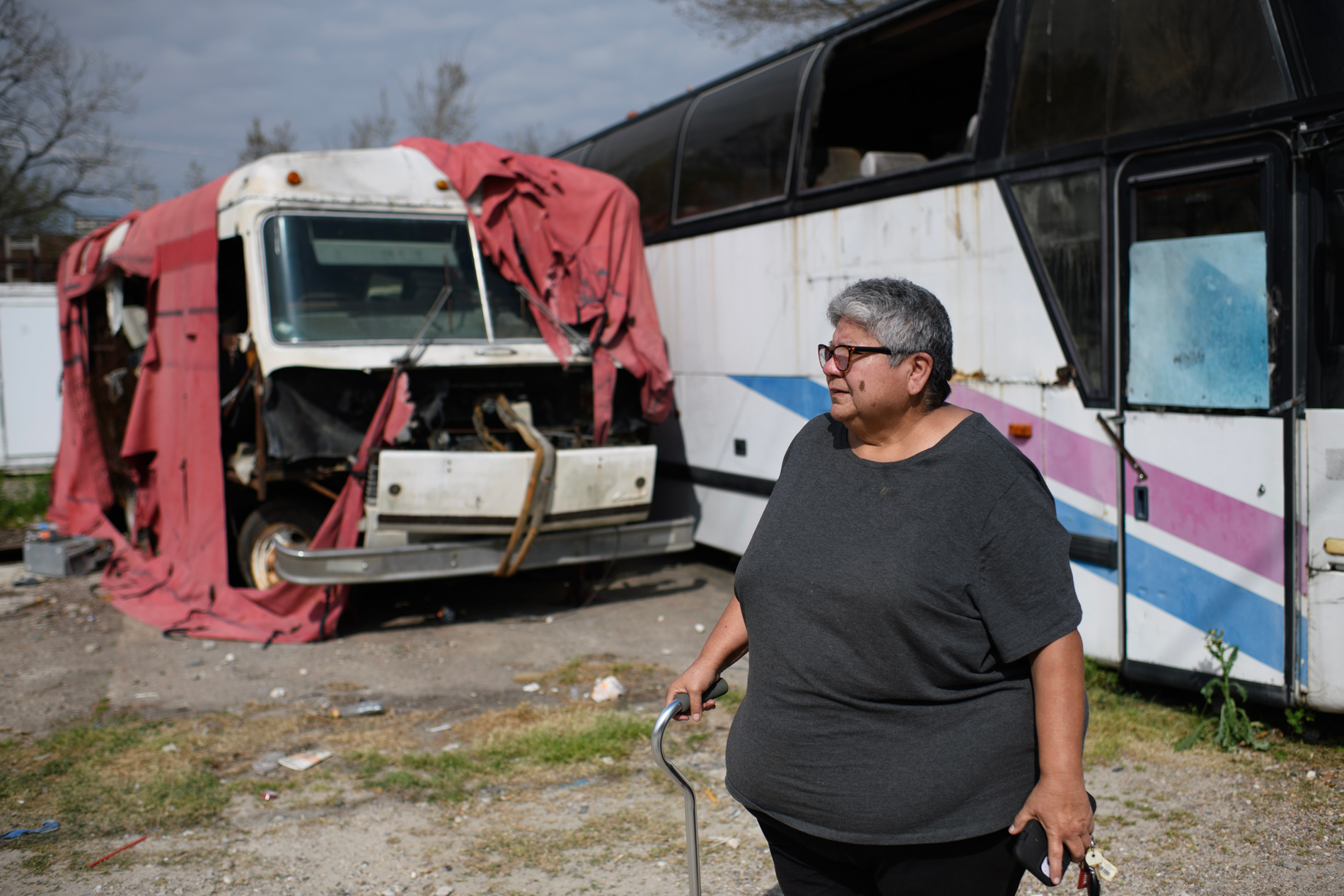|
Getting your Trinity Audio player ready...
|
As he waited at Houston’s new main Greyhound station in Magnolia Park for a ride to a halfway house after serving a 19-month prison term, Herman Stokley recalled the scene that greeted travelers at the old bus depot.
Stokley said drug-dealers on a seedy stretch of Main Street in Midtown would spot the formerly incarcerated and pitch them as soon as they got off the bus.
“Good riddance,” he said. “It was terrible.”

Stokley and several other formerly incarcerated people interviewed earlier this month called the new station a dramatic improvement, but said they had no intention of lingering there. Their mere presence in the neighborhood – prompted by Greyhound’s abrupt announcement in November that it was moving there – has sparked a backlash, however.
Magnolia Park residents say they worry the crime that plagued the old station could shift to the new one. So far, according to Houston Police Department statistics, those fears have not borne out.
Political leaders are united in frustration over the bus carrier’s sudden move, but are divided on how to respond.
Some, including state Rep. Christina Morales, D-Houston, say they will stop at nothing less than forcing Greyhound out. Others, such as City Councilmember Joaquin Martinez, say it is more realistic for officials to try to make the station and its surroundings as safe as they can.
“Let’s just be real with our community, but let’s also be there with them, as well,” he said.
National trend
When Greyhound announced in November 2023 that it was moving out of its longtime home at 2121 Main Street, business leaders and real estate developers in Midtown were ecstatic.
The station and a nearby McDonald’s restaurant had long since become bywords for crime and chaos on internet forums and headaches for police.
Instead of a location in the heart of the city, Greyhound passengers now would be dropped off at a longtime satellite depot at 7000 Harrisburg Boulevard, the company said. That station, near a METRORail Green Line stop, also hosts several bus lines that travel to and from the Rio Grande Valley or Mexico.
The small station, which is surrounded by a tall metal fence, has a line of bus bays on one side and parking spots on the other. It sits on a commercial strip of Harrisburg near mobile phone stores, payday loan shops and restaurants. A block to the north and south, they give way to fenced-off bungalows and battered industrial buildings.
Greyhound’s move to Magnolia Park was part of a national trend, according to Joseph Schwieterman, a professor at DePaul University in Chicago, who has studied the carrier.
Over and over, Greyhound is leaving downtown stations in favor of outlying locations. Those shifts are happening in part because of corporate maneuverings over the past few years that gave Greyhound a new owner, the German transportation company FlixBus, but deprived it of the land underneath its stations. The real estate was sold off to Twenty Lake Holdings, an investment firm owned by the hedge fund Alden Global Capital.
Twenty Lake Holdings put the Houston Greyhound station up for sale in January 2023.
Greyhound is a vital but often-overlooked part of the nation’s transportation network, Schwieterman said. Its sudden departures from city cores often have caught political leaders off guard.
“The stations needed attention for years, and now many governments are caught flat-footed, and travelers pay the price,” he said.
The shifts to new neighborhoods also have drawn frequent outcries. Residents in Columbus, Ohio have complained about spikes in crime near a new, suburban Greyhound location.
Patricia Cabrera, the director of an alliance of Houston neighborhood groups called East End Communities, said the move exacerbated the area’s sense that it is shut out of major decisions.
“This would only happen in certain neighborhoods. This would not have happened in other neighborhoods where you're going to make a move like that, or not alert the city councilman,” Cabrera said. “They just created a lot of bad will.”
Like other neighborhood leaders, Cabrera said her main concern was crime. Houston Police Department data show an increase in crime reports at the station itself, from one to eight incidents, in the two months after the move compared to the year before. That increase coincided with additional passenger traffic at what formerly was a minor satellite station.
However, overall crime in the surrounding police beat dropped 13 percent in the same period, to the lowest level for those two months since the start of the pandemic.
The Houston Police Department also has run the figures for a half-mile radius around the station. Dan Joyce, vice president of the East End District, said based on those numbers, at this point “there does not appear to be a trending difference in reported crimes in the vicinity of the new Greyhound station.”
Martinez said he believes some of the increase in reported crime at the station may be due to encouragement from him and others to call 911. Many of the incidents being reported are “nuisance” crimes, Martinez said.
“It’s not Midtown,” Martinez said. “I’m not saying there’s nothing going on there, but I’m not going to put this false sense of ‘don’t come down here, because you’re going to get shot.’”
Going home
On an average day, 18 people released from Texas Department of Criminal Justice custody pass through the Houston Greyhound station.
As she walked along a dilapidated stretch of Avenue B near the station on Friday, retired teacher Lucy Moreno said she was worried about the danger people leaving prison pose to children at nearby schools.
Could one of the men hopping off a prison bus, Moreno wondered, lurk in the alley’s debris?
Moreno said she is glad she already had installed a surveillance network around her home – 21 Ring security cameras to keep an eye on her rescue dogs. Pulling out her phone, she points to an email she received that morning about a theft a few blocks away.
“We never had that many alerts,” Moreno said.
Standing across from the Greyhound station, nonprofit leader Deb Walker said she could understand the neighborhood’s concerns. In her experience, however, people leaving prison simply are trying to get home as fast as they can.
Walker is the cofounder of 7More, a faith-based nonprofit that for years has assisted thousands of formerly incarcerated residents returning to Houston. On an unseasonably warm day last week, her group handed out bags with toiletries, donated t-shirts and bottled water to people waiting for their next bus.
Lea Grant, 44, was on her way to her mother and husband in Fort Worth after serving a six-month sentence. With no connections to Houston, Grant said she had no desire to spend any longer in the city than 45 minutes before her next bus.
“My family is so excited. They’re waiting on me,” she said.

Walker said the new station is a vast improvement from the old one, where people leaving prison would be swarmed by dealers and swindlers.
“The people from TDCJ have never been the problem,” Walker said. “They are trying to go on from there. It was, at the other Greyhound, the people in the area that were the problem.”
In response to neighborhood concerns, Martinez has pumped tens of thousands of dollars of his council district funds into additional, overtime patrols from police. Moreno said the added sweeps have given her some sense of security.
Morales, the state representative, said it was unfair that Martinez has to spend limited district funds on extra police patrols instead of amenities for the underserved neighborhood.
She says the city should push harder to force Greyhound out of the neighborhood. She wants Greyhound to move to an industrial area, though she has not identified a location.
“Yes, they're a private business, I get it, and they have a lease,” Morales said. “But, hey, when children’s safety is at risk, we should be outraged. And I am outraged and I will continue to be a thorn in their side until they move.”
Spreading civility
Pointing to the lease, Martinez said there is little the city can do to force Greyhound out. Hypothetically, the city could launch a lawsuit targeting the station as a nuisance property, he said. He sees that as a worst-case scenario, however.
“You need a certain number of crimes and a certain type of crime. And my goal is that we don’t ever get to that point,” he said.
Instead, Martinez said he will keep directing district money toward police patrols. He also is working with the East End District and neighborhood leaders to craft a petition for an expansion of the city’s “civility ordinance.”
The ordinance allows police to ticket people for sitting, lying down or placing any personal possessions on a sidewalk between the hours of 7 a.m. and 11 p.m.
Critics say the ordinance criminalizes homelessness. Supporters say the threat of citation gives police a way to nudge homeless people toward social services.
Martinez said he hopes to have the request on the City Council agenda in about three months.
Editor's Note: An earlier version of this story misidentified the light rail stop near the new Greyhound terminal. It is a Green Line stop.





